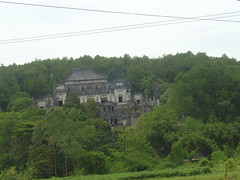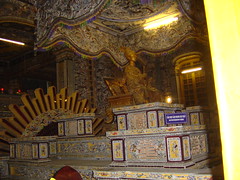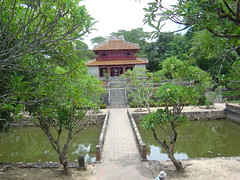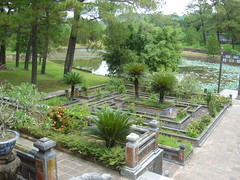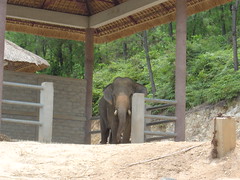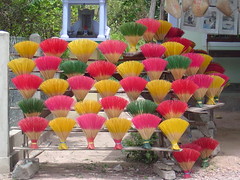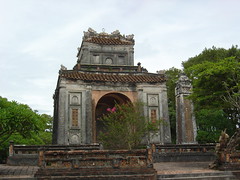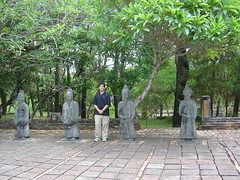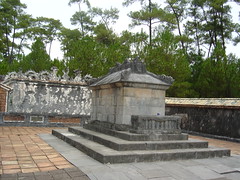The newest of the Nguyen Dynasty tombs is also the smallest. It also has the most prominant view. Located on the side of a hill, it is visible for miles around.
We arrived at the tomb during a rain shower and our guide rented us umbrellas right by the entrance. You have to love that capitalistic spirit in a socialist country. The temple is 130 steps up to the top and the rain makes the worn treads very slippery.
The temple is also the most "western" of the tombs with a lot of French influenced decoration. Khai Dinh was very taken with French style and many of the ornaments in the temple were imported from France. The tomb itself has a lif size statue of him sitting in a canopied chair.
We were inside the temple admiring the decor when the rain picked up dramatically and the power went out. The rain got so heavy that water was about to back up into the temple from the plaza outside. A worker went out and set a hose down to siphon off the rain to run down the steps instead.
After about a half hour, the rain had died down enough for us to risk the dash back down the steps to our van. The railings of the steps are elaborately carved dragons. The dragons can be seen in this post.
Tuesday, November 29, 2005
Sunday, November 20, 2005
Tomb of Minh Mang
The second tomb that we visited in Hue was the tomb of Emperor Minh Mang. This tomb complex is considered one of the finest complexes of the Nguyen Dynasty tombs. The buildings are laid out along a central axis and are flanked by by two large man made lakes. A third lake separates the main buildings from the actual tomb area. As seen from above, the lakes form the rough outline of a body with the round tomb area where the head would be.
The overall effect of the buildings, gardens and lakes is a serene contemplative atmosphere. Walking trails surround the large lakes and the total length of nature trails is several miles.
The main set of buildings are symmetrical around a central axis with a formal feel. The garden at the end of buildings just before the Tan Nuyet Lake is set in the shape of the Chinese longevity symbol that is a major feature of all the tombs.
As we were leaving this tomb, we greeted a group of Australian tourists that we had seen at the restaurant the previous night. In fact all day, we kept coming across the same people that were on roughly the same itenerary as us. Vietnam is an increasing popular tourist destination for Australians.
The overall effect of the buildings, gardens and lakes is a serene contemplative atmosphere. Walking trails surround the large lakes and the total length of nature trails is several miles.
The main set of buildings are symmetrical around a central axis with a formal feel. The garden at the end of buildings just before the Tan Nuyet Lake is set in the shape of the Chinese longevity symbol that is a major feature of all the tombs.
As we were leaving this tomb, we greeted a group of Australian tourists that we had seen at the restaurant the previous night. In fact all day, we kept coming across the same people that were on roughly the same itenerary as us. Vietnam is an increasing popular tourist destination for Australians.
Wednesday, November 16, 2005
Working Elephants
While traveling along a windy mountain road between tombs near Hue, we saw this elephant in his open air hut. Another elephant was in a hut right behind it. Down the hill in a much more ramshackle building were the owners of the elephants. They would let us take pictures but not get too close.
The elephants work in the forest pulling lumber. I think these elephants live better more comfortable lives than some of the local residents. I had always associated elephants with Thailand and India, completely unaware that they were in Vietnam as well.
The elephants work in the forest pulling lumber. I think these elephants live better more comfortable lives than some of the local residents. I had always associated elephants with Thailand and India, completely unaware that they were in Vietnam as well.
Wednesday, November 09, 2005
Roadside Incense
Just outside the gates of the very serene grounds of the Tu Duc Tomb complex near Hue was a row of tourist shops and small cafes catering to the tourists. Further down the road was this stand selling incense. The incense is beautifully arranged in these fan shaped arrangements. The colors were so pretty, we made the van turn around just so I could take some pictures.
Roadside stands in Vietnam tend to come in clusters. There is a Nobel prize winning theory behind this phenomena, but Vietnamese merchants have figured this out on their own. We would pass a pineapple stand to then pass about ten more in the next mile. A little further up the road would be a dozen stands in a row selling rice wine, then a group of stands selling something else.
There were a couple of other stands right near this one selling incense sticks as well, but this one had the prettiest arrangement. The incense was for pilgrims to the temples in the area. As we learned in Hanoi, all the major religious attractions are also working temples.
Roadside stands in Vietnam tend to come in clusters. There is a Nobel prize winning theory behind this phenomena, but Vietnamese merchants have figured this out on their own. We would pass a pineapple stand to then pass about ten more in the next mile. A little further up the road would be a dozen stands in a row selling rice wine, then a group of stands selling something else.
There were a couple of other stands right near this one selling incense sticks as well, but this one had the prettiest arrangement. The incense was for pilgrims to the temples in the area. As we learned in Hanoi, all the major religious attractions are also working temples.
Tuesday, November 01, 2005
Tu Duc Mausoleum
Scattered around the countryside around Hue are the tombs and mausoleums of the Nguyen Dynast rulers. Tomb is too light a word to use for these palatial monuments.
Each of these sites is really a summer palace complex that was built for each emperor. Construction would begin as soon as the emperor took the throne and would serve as a retreat from the Imperial City. Each one is different, reflecting the personality and ambition of it's emperor.
The first one we visited was the estate of the Emperor Tu Duc. The estate circles a beautiful lake and has several recreational pavillions surrounding the lake. Tu Duc considered himself a poet and he would sit in the pavillion overlooking the lake while he composed.
The Hoa Khiem Temple shown in the picture doubled as a working palace during his life and included a royal opera theater and lodging for his many concubines. After the the death of an emperor, his many concubines would often stay on as caretakers for the estate.
The actual sarcophogous is within a courtyard up a small hill. The courtyard outside the tomb includes rows of statues of horses, warriors and mandarins. These life size statues are to guard the tomb area.
There was a slave revolt during construction and the design was changed to reflect a new-found humility and modesty on the part of Tu Duc. He still had time for 50 course meals and dozens of concubines.
Unlike western tombs, the Tu Duc Mausoleum is open air and exposed to the elements. Our guide told us that the actual bodies of the emperors were buried in secret locations to avoid grave robbers.
The lake and gardens including a beautiful wooded area were magnificent but very hot. We went through two bottles of water each on the brief hour tour we took of the grounds. Fortunately there were several concession stands set up just for that need.
Each of these sites is really a summer palace complex that was built for each emperor. Construction would begin as soon as the emperor took the throne and would serve as a retreat from the Imperial City. Each one is different, reflecting the personality and ambition of it's emperor.
The first one we visited was the estate of the Emperor Tu Duc. The estate circles a beautiful lake and has several recreational pavillions surrounding the lake. Tu Duc considered himself a poet and he would sit in the pavillion overlooking the lake while he composed.
The Hoa Khiem Temple shown in the picture doubled as a working palace during his life and included a royal opera theater and lodging for his many concubines. After the the death of an emperor, his many concubines would often stay on as caretakers for the estate.
The actual sarcophogous is within a courtyard up a small hill. The courtyard outside the tomb includes rows of statues of horses, warriors and mandarins. These life size statues are to guard the tomb area.
There was a slave revolt during construction and the design was changed to reflect a new-found humility and modesty on the part of Tu Duc. He still had time for 50 course meals and dozens of concubines.
Unlike western tombs, the Tu Duc Mausoleum is open air and exposed to the elements. Our guide told us that the actual bodies of the emperors were buried in secret locations to avoid grave robbers.
The lake and gardens including a beautiful wooded area were magnificent but very hot. We went through two bottles of water each on the brief hour tour we took of the grounds. Fortunately there were several concession stands set up just for that need.
Subscribe to:
Posts (Atom)
